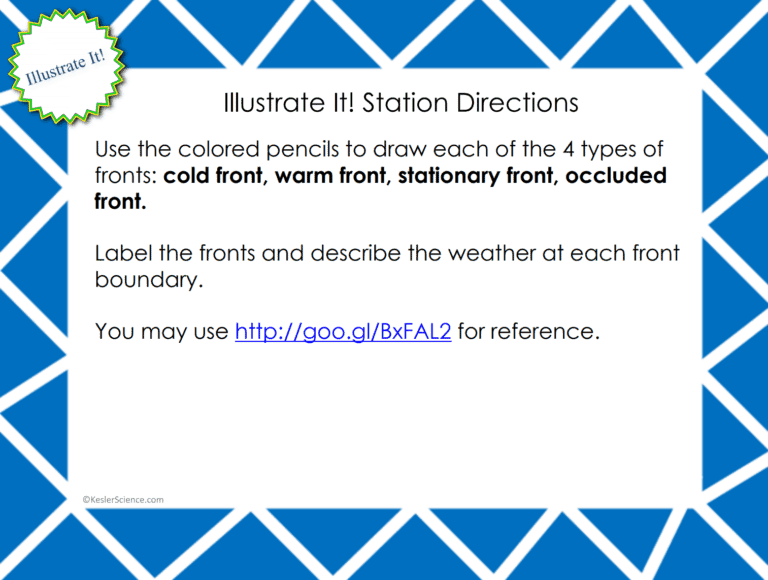Weather Maps and Air Pressure Lesson Plan - A Complete Science Lesson Using the 5E Method of Instruction
At the end of this weather maps and air pressure lesson plan, students will be able to identify how global patterns of atmospheric movement influence local weather using weather maps that show high and low pressures and fronts. Each lesson is designed using the 5E method of instruction to ensure maximum comprehension by the students.
The following post will walk you through each of the steps and activities from the weather maps and air pressure lesson plan.
ENGAGEMENT
Objective Introduction
At the beginning of the lesson, the class will do a Think-Pair-Share to discuss the objective.
Class Activity
- Tell students that today they will be learning about pressure systems and fronts and how they affect local weather.
- Show the video using the provided link (stop at 1:31) or demonstrate how air pressure crushes a soda can.
Student Activity
- Post the words high pressure and low pressure on the board.
- After the demonstration or stopping the video at time 1:31, ask students to explain what happened inside the can.
- Have students draw a diagram of what the molecules inside the soda can are doing during heating. Hopefully, they will remember that when boiling water, the molecules expand creating more pressure inside the can.
- Ask students to explain what happened when the can was cooled. Again they should remember that when molecules cool, they condense taking less space creating less pressure.
- Ask students to think about how the difference in air pressure (high and low) affect the air around us.
- Show the rest of the video and have students discuss with a partner whether their answers were correct or not.

The teacher will help to clear any misconceptions about weather maps and air pressure. A major misconception is that students think that humid air is oppressive and heavy, and humid air is denser than dry air. Also, they may think that air only exerts force or pressure when it is moving.
Estimated Class Time for the Engagement: 20-30 minutes
EXPLORATION
This student-centered station lab is set up so students can begin to explore weather maps and air pressure. Four of the stations are considered input stations where students are learning new information about weather maps and air pressure and four of the stations are output stations where students will be demonstrating their mastery of the input stations. Each of the stations is differentiated to challenge students using a different learning style. You can read more about how I set up the station labs here.
EXPLORE IT!
Students will be working in pairs to better understand air masses. In this station, students will be operating as weather forecasters as they read maps to determine the types of fronts approaching certain cities in the US. The students will follow the steps and record their observations on their lab sheet.
WATCH IT!
At this station, students will be watching a short video explaining air masses. Students will then answer questions related to the video and record their answers on their lab station sheet. For example: Describe what a front is. Describe what an air mass is. Explain how a cold front is formed.
RESEARCH IT!
The research station will allow students to explore an interactive webpage that has students take a scientific approach to understanding the air masses. Students will be instructed to complete a few tasks and record answers on their lab sheets.
READ IT!
This station will provide students with a one page reading about air masses. There are 4 follow-up questions that the students will answer to show reading comprehension of the subject.
ASSESS IT!
The assess it station is where students will go to prove mastery over the concepts they learned in the lab. The questions are set up in a standardized format with multiple choice answers. Some questions include: What kind of front occurs when a cold air mass replaces a warm air mass? What kind of weather would you expect in Denver, CO? Which is the best description for a stationary front?
WRITE IT!
Students who can answer open-ended questions about the lab truly understand the concepts that are being taught. At this station, the students will be answering three task cards: How does density relate to cold and warm air masses? Describe the expected weather in your town if a cold front is going to be moving in within the next 12 hours. How are cold fronts different from stationary fronts?
ILLUSTRATE IT!
Your visual students will love this station. Students are to create four drawings that represent the 4 types of air fronts (cold, warm, stationary, occluded).

ORGANIZE IT!
Students at this station will match the sets of cards. Students will read series of cards and will match the visual with the names and descriptions of the 4 types of air fronts. Once students have completed their organization, the teacher will check their understanding.
Estimated Class Time for the Exploration: 1-2, 45 minute class periods
EXPLANATION
The explanation activities will become much more engaging for the class once they have completed the exploration station lab. During the explanation piece, the teacher will be clearing up any misconceptions about weather maps and air pressure with an interactive PowerPoint, anchor charts, and notes. The weather maps and air pressure lesson include a PowerPoint with activities scattered throughout to keep the students engaged.
The students will also be interacting with their journals while taking notes from the PowerPoint. If you have students that need modified notes, the 5E lessons come equipped to help give every student access to the lesson.
Estimated Class Time for the Exploration: 2-3, 45 minute class periods
ELABORATION
The elaboration section of the 5E method of instruction is intended to give students choice on how they can prove mastery of the concept. When students are given choice the ‘buy-in’ is much greater than when the teacher tells them the project they will have to create. The elaboration project will allow students to create a video, podcast, newscast, blog, or even a Prezi.
Estimated Class Time for the Elaboration: 2-3, 45 minute class periods (can also be used as an at-home project)
EVALUATION
The final piece of the 5E model is to evaluate student comprehension. Included in every 5E lesson is a homework assignment, assessment, and modified assessment. Research has shown that homework needs to be meaningful and applicable to real-world activities in order to be effective. When possible, I like to give open-ended assessments to truly gauge the student’s comprehension.
Estimated Class Time for the Elaboration: 1, 45 minute class period
DOWNLOAD THE FULL LESSON NOW
The full lesson is available for download from the Kesler Science Store. Save yourself a ton of time and grab it now.
Download Over $100 in FREE Resources
For Middle School Science
Simply create a login below and gain immediate access to a selection of our Kesler Science product line worth $100 - for FREE. There's a full version of every product type! You'll also join tens of thousands of middle school science teachers who receive timely tips and strategies straight to their inbox.


.png)



